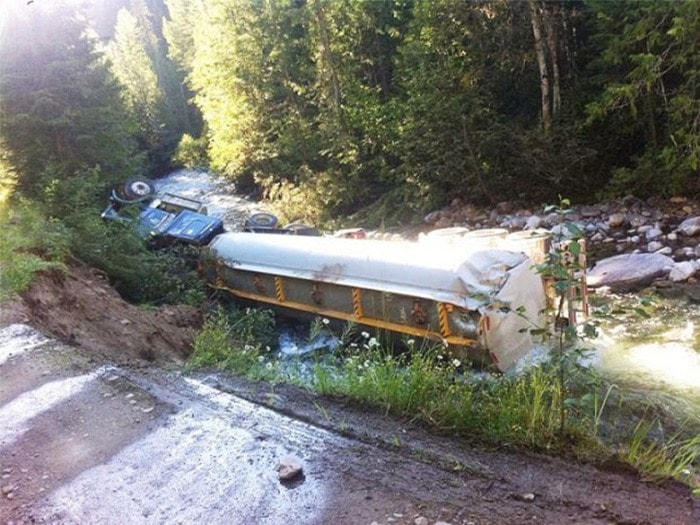Revelstoke would take a two pronged approach in case of a toxic spill in a local waterway, says the local emergency management co-ordinator.
"One is public safety and one is spill management," Simon Hunt told the Times Review.
The first step would be to contact Emergency Management B.C. and declare a state of emergency, he said. Next, they would determine a safe zone around the spill to make sure people were safe. Afterwards, a spill containment team would be brought in to do cleanup around affected areas and prevent the spill from spreading.
"It would be up to the environmental spill team, they would determine the extent of the damage and the approach we would use to contain the spill," said Hunt.
The Times Review spoke to Hunt after a tanker truck carrying 35,000 litres of A1 jet fuel crashed on a forestry road near Lemon Creek in the Slocan Valley, spilling its load into the creek and contaminating the local environment on Friday, July 26.
A state of emergency was called and 800 homes along Lemon Creek and the Slocan River were evacuated as toxic fumes permeated the air. The order was later expanded to include 2,500 homes.
"The concern is inhaling fumes hazardous to one's health and the explosive nature of jet fuel," said Bill Macpherson, the information officer for the Regional Disirtc of Central Kootenay, on Friday. "It does dissipate fairly quickly. With any luck, this order will be short lived, but it's hard to say."
Residents either took refuge with friends or at one of three shelters set up in Nelson and Slocan City. Having heard about the disaster before bed, Brian Rosen had a restless night at his home in Shore Acres a couple hundred feet from the Slocan River on Friday. And on Saturday morning at 6 a.m., he was asked to leave.
“I just worry about the river, really — the fish and the plants, really,” he said a few hours later. “It’s been untouched so far. Now it’s touched and this is a big wake-up call for the Kootenays. We live in this secluded area and we think that everything is so pristine but it just takes one truck.”
Gwen Rasmussen was woken at about 1:30 a.m. and asked to leave her Passmore home. By the time they departed an hour later, she could smell the fuel in the air. She described the smell as being similar to diesel.
“What a shock. It seems like there is just one disaster after another,” she said. “The environmental damage that’s going to be done to that river is going to have such an effect on the wildlife.”
On Saturday, the evacuation order was lifted and residents were allowed home. Highway 6, which was closed following the crash, was re-opened too.
A health advisory was issued by Interior Health warning people not to drink water or swim in the Slocan and Kootenay Rivers downstream from the site of the spill. IH also advised against eating fish caught from those rivers.
Dr. Trevor Corneil, medical health officer, said he does not expect any long-term effects from the jet fuel spill but wants residents to take precautions in the short-term.
"Certainly above the [Brilliant] dam, it's a do not use water advisory which includes drinking, swimming, fishing and recreation until such time as the Ministry of Environment is able to sort out that things are clean," Corneil told the Castlegar News in a phone interview Sunday.
A boom was placed along the Kootenay River near its confluence with the Columbia River in order to soak up spilled jet fuel before it passed through the Brilliant Dam.
With respect to a video showing dead minnows in the Slocan River, Corneil said damage would likely be short term and any long-term ecological impact would be clarified by the Ministry of Environment after testing of sediment and fish.
"We do advise people follow our updates for the next 48 to 72 hours," he said. "We've had a small number of people, under 15, presenting just within the first 24 hours to New Denver emergency. A few people in Nelson, too, but we're not sure if those were related to the spill. Some people did have burning in their throats but that's certainly the worst that we have heard. No one has been admitted [to hospital]."
In an earlier news release, Interior Health stated: “The fuel involved (jet fuel A-1) is a volatile organic compound that in high concentrations (liquid or gas) can cause significant damage to skin, lung tissue, gastrointestinal tissue, and brain tissue. Volatile organic compounds such as these can also exacerbate any chronic diseases such as emphysema, heart disease, and neuromuscular disorders.”
The tanker was removed from the creek on Sunday. Executive Flight Services of Calgary, which owned the tanker, has the lead role in remediation efforts at the site, according to the Regional District of Central Kootenay.
The tanker made a wrong turn onto Lemon Creek forest service road while heading to a fueling station for helicopters tackling the Perry Ridge wildfire (see page 5).
With reporting from the Nelson Star and Castlegar News.
